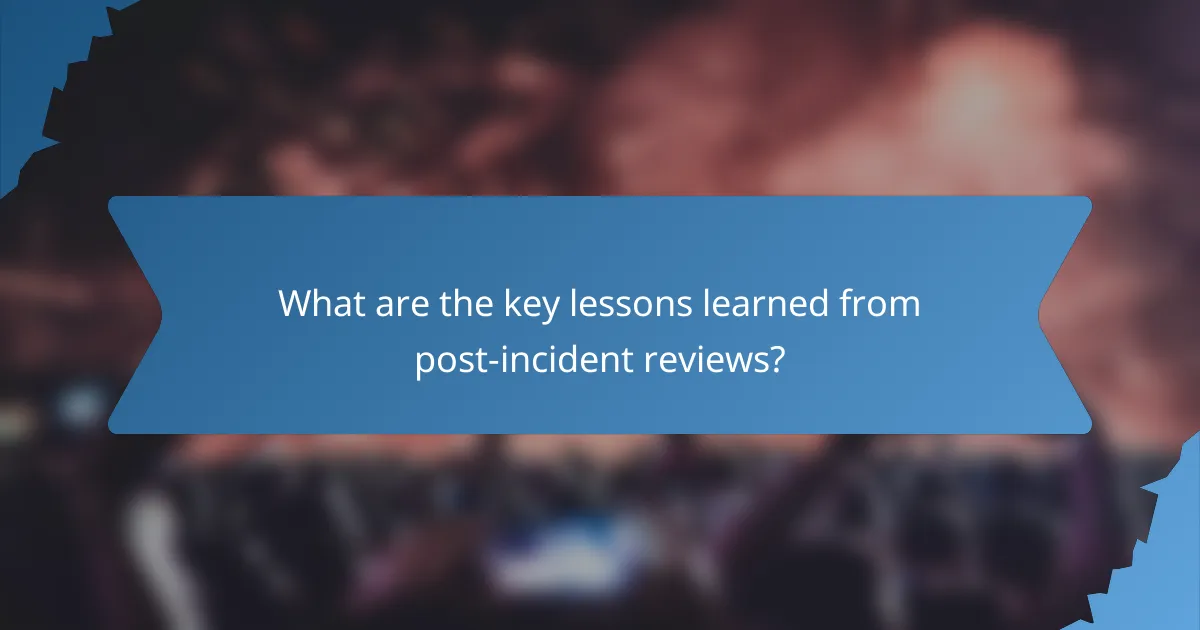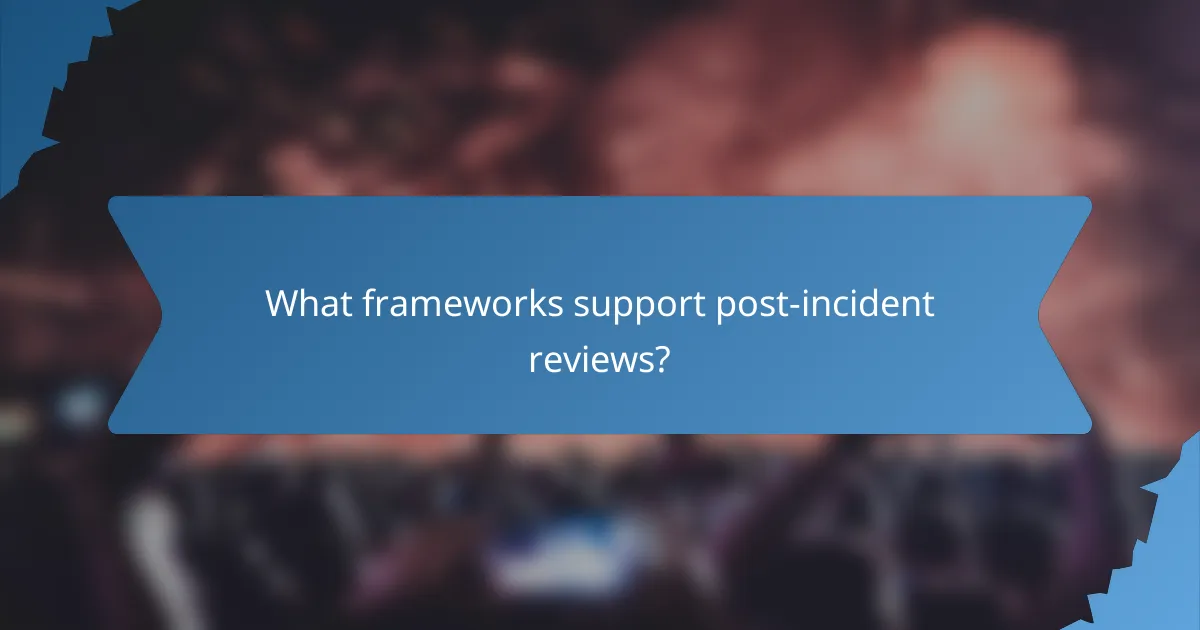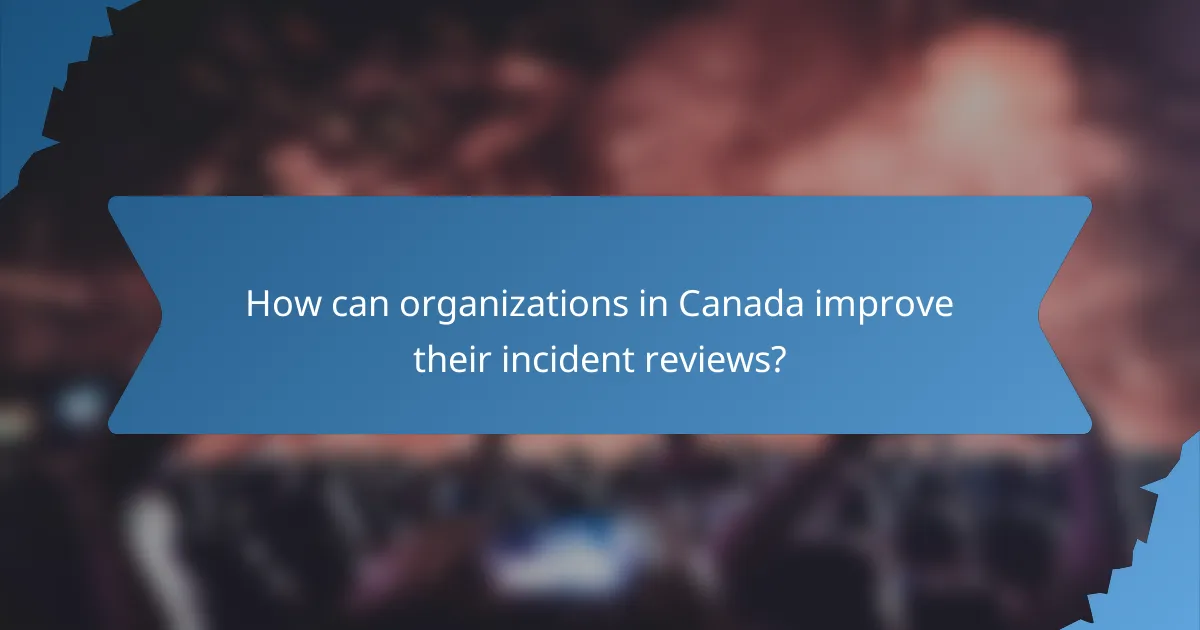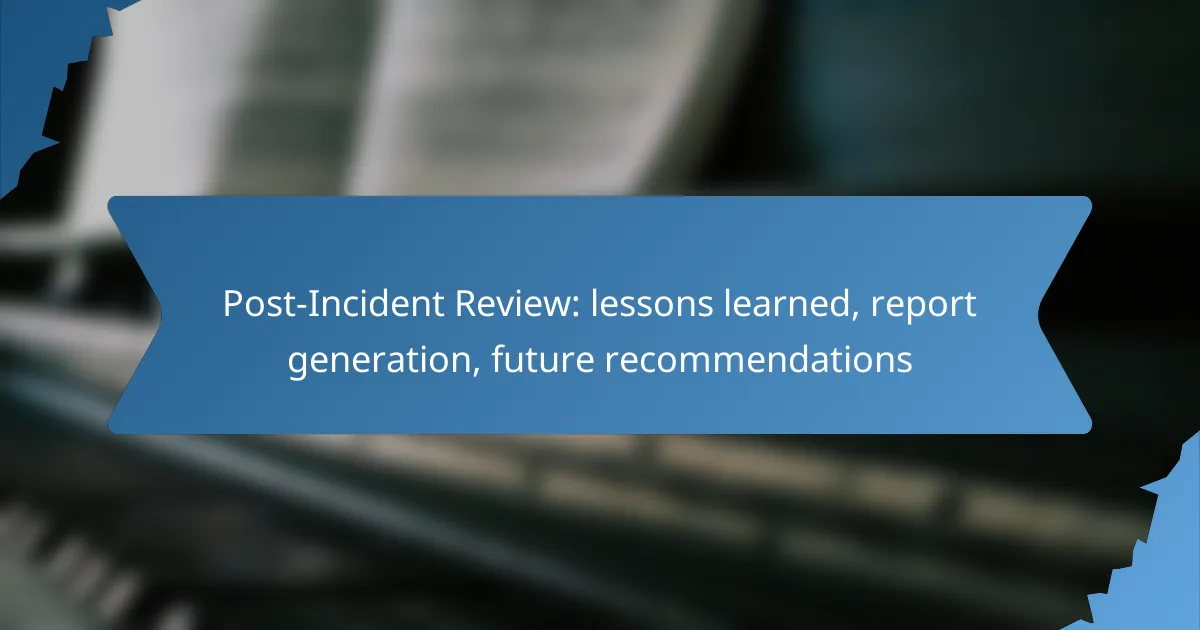Post-incident reviews are crucial for organizations to identify underlying causes, refine response strategies, and enhance team communication. By generating effective reports that detail incidents and lessons learned, organizations can improve their future incident management and resilience. Recommendations for future preparedness should emphasize regular training, updated response plans, and investment in monitoring tools to mitigate the impact of potential incidents.

What are the key lessons learned from post-incident reviews?
Key lessons from post-incident reviews include understanding the underlying causes of incidents, refining response strategies, and improving team communication. These insights help organizations enhance their resilience and prevent future occurrences.
Identifying root causes
Identifying root causes is crucial for effective post-incident reviews. This process involves analyzing the incident to determine what went wrong and why, often using techniques like the “5 Whys” or fishbone diagrams. By pinpointing the fundamental issues, organizations can address systemic problems rather than just symptoms.
For example, if a server outage occurred due to a software bug, the root cause analysis might reveal inadequate testing procedures. This insight can lead to improved testing protocols to prevent similar issues in the future.
Improving response strategies
Improving response strategies involves evaluating how incidents were managed and determining what can be done better next time. This includes assessing the effectiveness of the incident response plan and the speed of the team’s reaction. Organizations should consider conducting drills to simulate incidents and refine their response processes.
For instance, if a security breach response took too long, the review might highlight the need for faster communication channels or clearer roles within the response team. Regular updates to the response strategy can significantly enhance preparedness.
Enhancing team communication
Enhancing team communication is vital for effective incident management. During an incident, clear and timely communication can prevent confusion and ensure that all team members are aligned. Post-incident reviews should assess how information flowed during the event and identify any breakdowns in communication.
To improve communication, organizations can implement standardized reporting protocols and use collaborative tools that facilitate real-time updates. Regular training sessions can also help teams practice effective communication under pressure.
Documenting incident impacts
Documenting incident impacts provides valuable insights into the consequences of an event. This includes assessing financial losses, operational disruptions, and reputational damage. A thorough impact analysis helps organizations understand the severity of incidents and prioritize future prevention efforts.
For example, if a data breach resulted in significant customer churn, documenting this impact can inform decisions about investing in better security measures. Keeping detailed records also aids in compliance with regulations and can be useful for insurance claims.
Implementing preventive measures
Implementing preventive measures is the final step in the post-incident review process. After identifying root causes and impacts, organizations should develop strategies to mitigate future risks. This may involve updating policies, investing in new technologies, or providing additional training for staff.
For instance, if a recurring issue is identified, such as outdated software, organizations should prioritize updates and maintenance schedules. Regular reviews of preventive measures can help ensure they remain effective over time.

How to generate effective post-incident reports?
Effective post-incident reports provide a comprehensive overview of an incident, detailing what occurred, the response, and lessons learned. These reports are essential for improving future incident management and preventing recurrence.
Structuring the report
A well-structured report enhances readability and ensures that critical information is easily accessible. Start with an executive summary that outlines the incident’s key points, followed by sections detailing the incident timeline, response actions, and outcomes.
Consider using headings and subheadings to break down complex information into digestible parts. This organization helps stakeholders quickly find relevant details and understand the incident’s context.
Including key metrics
Incorporating key metrics is vital for quantifying the incident’s impact and response effectiveness. Metrics such as response time, downtime duration, and the number of affected users provide a clear picture of the incident’s severity.
Use benchmarks to compare these metrics against industry standards or previous incidents. This comparison can highlight areas for improvement and validate the effectiveness of response strategies.
Utilizing clear language
Using clear and concise language is crucial for ensuring that the report is understood by all stakeholders, regardless of their technical background. Avoid jargon and technical terms unless necessary, and provide definitions when they are used.
Be direct and specific in your descriptions to eliminate ambiguity. For instance, instead of saying “the system had issues,” specify “the system experienced a 30% increase in response time during peak hours.”
Incorporating visuals
Visual elements such as charts, graphs, and timelines can significantly enhance the report’s clarity and impact. They help to illustrate complex data and trends, making it easier for readers to grasp the incident’s implications.
For example, a timeline can effectively show the sequence of events leading up to the incident, while a bar graph can compare response times across different incidents. Ensure that visuals are labeled clearly and referenced in the text for context.

What future recommendations should be made?
Future recommendations should focus on enhancing preparedness and response capabilities to minimize the impact of incidents. Key areas include regular training, updating response plans, investing in monitoring tools, and conducting follow-up reviews.
Regular training sessions
Regular training sessions are essential for ensuring that all team members are familiar with incident response protocols. These sessions should be conducted at least quarterly and can include simulations of various incident scenarios to test readiness.
Consider incorporating diverse training formats, such as workshops, tabletop exercises, and online courses. This variety helps engage participants and reinforces learning through different methods.
Updating incident response plans
Updating incident response plans is crucial to reflect changes in technology, personnel, and organizational structure. Plans should be reviewed and revised at least annually or after significant incidents to incorporate lessons learned.
Involve key stakeholders in the update process to ensure that all perspectives are considered. This collaboration can lead to a more comprehensive and effective response strategy.
Investing in monitoring tools
Investing in monitoring tools can significantly enhance an organization’s ability to detect and respond to incidents in real-time. Tools such as intrusion detection systems, log management solutions, and security information and event management (SIEM) systems are valuable assets.
When selecting tools, consider factors like scalability, ease of integration, and the specific needs of your organization. Regularly assess the effectiveness of these tools to ensure they meet evolving security challenges.
Conducting follow-up reviews
Conducting follow-up reviews after an incident is vital for understanding what went wrong and how to improve future responses. These reviews should be thorough and involve all relevant stakeholders to gather diverse insights.
Establish a structured process for documenting findings and recommendations. This documentation can serve as a reference for future training and planning, ensuring continuous improvement in incident management practices.

What frameworks support post-incident reviews?
Several frameworks facilitate effective post-incident reviews, helping organizations analyze incidents, document findings, and implement improvements. These frameworks provide structured approaches to ensure lessons learned are captured and future incidents are mitigated.
Incident Command System (ICS)
The Incident Command System (ICS) is a standardized approach to incident management that enables effective coordination during emergencies. It provides a clear hierarchy and defined roles, which helps streamline communication and decision-making processes.
When conducting a post-incident review using ICS, focus on evaluating the command structure, resource allocation, and communication effectiveness. Consider documenting the timeline of events and any challenges faced to improve future incident responses.
Common pitfalls include neglecting to involve all relevant stakeholders in the review process and failing to update the incident command protocols based on lessons learned. Regular training and drills can enhance familiarity with ICS and improve overall response effectiveness.
After Action Review (AAR)
The After Action Review (AAR) is a reflective practice that occurs after an incident, allowing teams to discuss what happened, what went well, and what could be improved. This framework emphasizes open dialogue and constructive feedback among team members.
To conduct an effective AAR, gather all participants shortly after the incident to discuss their perspectives. Focus on key areas such as objectives met, unexpected challenges, and areas for improvement. Document findings and recommendations for future reference.
Ensure that AARs are conducted in a non-punitive environment to encourage honest feedback. Avoid vague conclusions; instead, aim for specific, actionable recommendations that can be implemented in future incidents. Regularly revisiting AAR findings can help reinforce lessons learned across the organization.

How can organizations in Canada improve their incident reviews?
Organizations in Canada can enhance their incident reviews by implementing structured processes that focus on thorough analysis and actionable insights. This involves adopting best practices, engaging local experts, and fostering a culture of continuous improvement.
Adopting industry best practices
To improve incident reviews, organizations should adopt industry best practices such as the ITIL framework or NIST guidelines. These frameworks provide a structured approach to incident management, ensuring that reviews are comprehensive and systematic.
Key steps include documenting incidents in detail, analyzing root causes, and tracking corrective actions. Regularly updating incident response plans based on lessons learned can also help prevent future occurrences.
Organizations should consider conducting regular training sessions for staff to familiarize them with these best practices. This can lead to improved response times and more effective incident management overall.
Engaging local experts
Engaging local experts can significantly enhance the quality of incident reviews. These professionals bring valuable insights into regional regulations, industry standards, and specific challenges faced by organizations in Canada.
Collaboration with local cybersecurity firms or consultants can provide tailored recommendations that address unique organizational needs. Additionally, participating in local industry forums can help organizations stay informed about emerging threats and effective mitigation strategies.
Organizations should also consider establishing partnerships with local universities or research institutions to leverage academic expertise in incident analysis and prevention. This can foster innovation and improve overall incident response capabilities.

What emerging trends impact post-incident reviews?
Emerging trends in post-incident reviews focus on leveraging technology and data analytics to enhance the review process. These trends include the integration of AI tools, which can streamline data analysis and improve decision-making.
Integration of AI tools
Integrating AI tools into post-incident reviews allows organizations to automate data collection and analysis, reducing the time required to generate reports. AI can identify patterns and anomalies in incident data that may not be immediately apparent to human analysts.
For example, machine learning algorithms can analyze historical incident data to predict potential future incidents, enabling proactive measures. Organizations can also use AI-driven sentiment analysis to gauge team morale and communication effectiveness during incidents.
When implementing AI tools, it is essential to ensure data quality and relevance. Organizations should avoid over-reliance on AI by combining its insights with human expertise to achieve a comprehensive understanding of incidents. Regularly updating AI models with new data will also enhance their accuracy and effectiveness.
